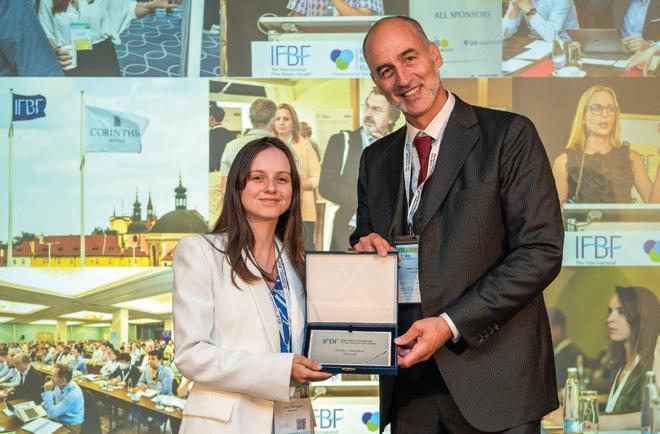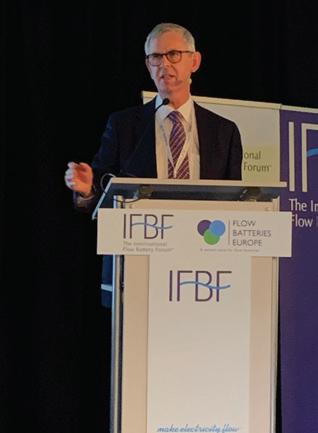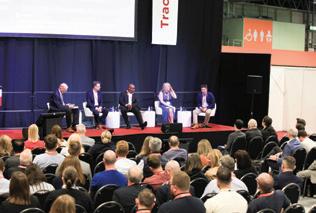
5 minute read
Buoyant industry all set to let the good times flow
Brimming with optimism would be how one could best describe the flow battery industry as the curtain went up for its annual gathering last year in Brussels. This year, ‘raring to go and uncompromising’ neatly sums up the mood of their get-together in Prague.

Advertisement
There was more than a spring in every delegate’s step, fresh from a flurry of flow battery news including the announcement by iron flow battery firm ESS that it would be building a 50MW/500MWh system in Germany.
Australia’s Redflow had not long secured a 20MW microgrid project for Northern California, while Invinity Energy Systems said just weeks earlier it was developing a 30MWh VRFB battery in the UK.
Another piece of good news was that flow battery technology will also now be included in the EU Battery Passport scheme.
And just six months before the conference, CellCube announced a deal to build a manufacturing and assembly line for its vanadium redox flow batteries in Australia.
All this news and more was regaled to delegates and IFBF secretary and secretary-general of Flow Batteries Europe (FBE), Anthony Price, who was rightly enthusiastic as he opened proceedings.





“Look at the growth in the sector — we have heard project reports from Asia, Europe, the Middle East and America that show how better batteries are meeting market needs,” he said.
According to a paper presented by FBE, some 8GW of flow batteries are forecast to be put into operation around the world by the end of the decade.
However, talking to Batteries International at networking and other events behind the scenes, many thought several other commercial initiatives will push that figure further.
Indeed, this year’s event received more than 40 papers, complementing the broad range of commercial, regulatory, policy and technical issues discussed during the conference.
Another key measure of the IFBF’s growing influence was the exhibition — this year more than a dozen stands representing battery makers, materials and service providers to name but a few, all set out in a designated conference room of their own.
Poster presentations were there aplenty too, highlighting R&D that is going on behind the scenes.
But a related exciting innovation was the ‘Poster Speed Pitch’, introducing the industry’s next generation of potential flow battery innovators, who each had just 60 seconds to outline their R&D work on stage during the main conference and lobby delegates to visit their poster stand.
How flow batteries could be the future of powering the rebuilding of more challenging environments was underscored by the attendance of two representatives from Ukrainian company R.Flo.
Head of technology Yaroslav Kolosovskyi and CEO Andrii Bondar were made to feel especially welcome by delegates. The pair explained that their attendance was only possible thanks to being provided with safe passage out of their homeland by the Ukrainian Armed Forces.
Also looking to the future was the flow battery industry itself and some changes are already underway.
Patrick Clerens, managing director of Clerens NV, announced that his organization would take over the “heavy lifting” needed behind the scenes in running future IFBF events — but with industry champion Price remaining very much a key player in proceedings, as we report in our news pages elsewhere in this issue.
Price said the partnership would help to expand the breadth of coverage, networking and showcasing opportunities for the flow batteries sector.
IFBF now heads toward its 15th year and has a date in Scotland, thanks to an invitation by Invinity Energy Systems CEO Larry Zulch for IFBF to convene there in 2024 — and visit its flow battery facility in the country.

The company builds its cell stacks in Scotland, Vancouver and China.
Zulch had earlier unveiled Invinity’s next-generation VFB project, ‘Mistral’, suitable for large scale (+500MWh) wind, utility and solar installation projects based on the firm’s VS3 technology.
He also provided food for thought when he suggested it might be time to drop ‘redox’ when talking about flow batteries in favour of only ‘vanadium flow batteries’, as the sector “enters the mainstream”.
However, a quick show of hands among the audience indicated mixed views.
The logistics of the Scotland trip will be announced in due course, but the conference was left in no doubt about Anthony Price’s preferred means of travel...

He told delegates that advances in the industry are such, they would be able to take a cruise in the not-toodistant future on a vessel powered by flow batteries.
Watch this space!
Advanced Tech and Innovation shows, NEC, Birmingham, UK June 29-30, 2023
Four events in one. This was held in two giant halls at the UK’s National Exhibition Centre. These were The Advanced Materials Show, Ceramics UK, Battery Cells & Systems Expo and Vehicle Electrification Expo.


Innovative mix and match technology exhibition highlights the evolving cross-fertilization of related ideas
Not just a good event, but a truly interesting one. That was the concluding comment of one attendee at the launch of this the second year of these four co-located shows. The venue was the same as last year but the location within the National Exhibition Centre on the outskirt of Birmingham in England, was a prime spot: a few hundred metres from the main entrance into the largest conference centre in the UK.
The NEC is huge and this exhibition took full advantage of the space available using two of the 20 interconnecting halls on this 182,000m³ venue.
The layout within the two halls is important. Each of the four conferences fitted (roughly) into one quarter of the overall space enabling visitors to stroll, for example, from one area, perhaps the vehicle electrification area seamlessly into a related subject area, such as that for battery cells and then into advanced materials.
The charm of the idea is this ability to wander. Nowadays one can’t speak of just a single technical area without looking at the related technologies. In this it was cleverly put together. Too much of modern electrochemical advances are isolated from their context in terms of materials and engineering.
In each corner there was a stage with around 100 seats facing the speakers in which that subject theme of the conference was discussed and there was a constant succession of well known figures and lively panel discussions throughout both days of the exhibition.


“My favourite part of the show has been having all the different elements in the same place: advanced batteries, EVs, ceramics and the like,” said one delegate.
“It’s been really good to have those cross-fertilization discussions and linking up with people who we may not have had the opportunity to link up with if it had been a single industry-focused event.”
One of the underlying themes discussed was how the UK would fare in attracting gigafactory battery manufacturing given the huge tax subsidies offered by the US in last year’s Inflation Reduction Act.
Bob Galyen, the former CTO of CATL and also acknowledged as one of a small coterie of international lithium battery experts the IRA was going to provide huge benefits for US automanufacturers and battery makers.
“If you look at research from Benchmark Mineral Intelligence,” he said, “you’ll see that Tesla and its battery partner could receive $41 billion in government tax credits by the end of 2032 — that’s far more than its key Detroit rivals.

